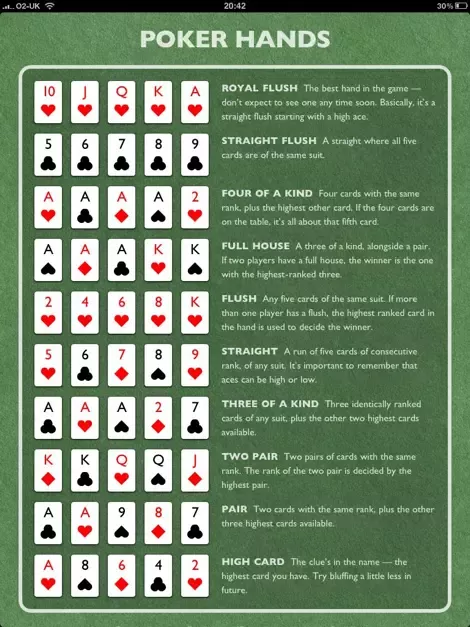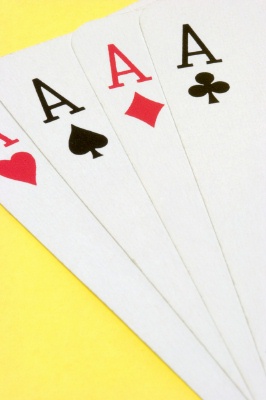
The highest possible straight flush, and the best hand in poker, is an ace high straight flush, also known as a Royal Flush. A royal flush consists of a straight from ten to the ace with all five cards of the same suit (A♥ K♥ Q♥ J♥ 10♥). A royal flush is exceptionally rare and is.
A Guide to Hand Rankings and How to Know When You are Beaten
There are many poker formats with different rules. One thing they have in common is the poker hand rankings. This is a standardized list of what beats what when it comes to the end of a hand. Note that certain ‘low hand’ or split pot games have different rankings for the strong low hands.
This page explains how the hand rankings work. It then goes further, adding an element of poker strategy. In poker hand strength can change throughout the hand. For example, you might have a pair of red aces and be ahead on the flop. If you face a big bet after the community cards have 4 clubs – those aces are unlikely to be the best hand.
Here is how the information on what beats what is laid out:
4 Aces Cards
- Detailed Poker Rankings: What hand beats what, and how to decide the winner for tied-hands.
- When Your Good Hand is Beaten: Basics of situations where you should play strong hands cautiously.
- Special Notes for Hi-Lo Poker Games: Not all poker games award the pot to the highest hand.
Detailed Poker Hand Rankings: What Beats What at Showdown
All standard poker games use 5 cards to determine the winner. This applies in Texas Hold’em, where you have 7 cards in total (2 in your hand, 5 on the board). Only 5 cards are used as showdown, with the 6th and 7th card completely irrelevant.
Here are the standard rankings, with notes on deciding the winner where more than one player has the same hand:
Royal Flush / Straight flush
Consecutive cards which are all the same suit make a ‘straight flush’. This is a super-powerful hand, and only comes up occasionally. A Royal Flush (ace, king, queen, jack and ten of the same suit) is simply the highest possible straight flush. This hand is unbeatable.
Where two players have a straight flush, the highest ranked card comes into play.
For example, if one player holds the 6 of hearts and another player the jack of hearts – and the board comes out including the 7, 8, 9 and 10 of hearts – both players have made a straight flush. In this case, the pot gets awarded to the player holding the jack.
4 of a Kind
4 Aces Wholesale
Also known as Quads, this hand can be of any rank, with 4 aces being the best hand. There are situations in Hold’em where 4 identical cards will hit the community card board. When this happens, the highest 5th card comes into play.
Where the 5th community card is a king, the pot would be split. If that community card is a low one, then the pot is awarded to the player with the highest unique card. For example, one player holds a pair of 7’s, and the other holds jack-queen.
Here the highest hand is A-A-A-A-Q.
Full House
This hand is 3 of one rank, along with two of another. An example is 4-4-4-K-K. There are some situations in which more than one player can have a full house.
If there are 3 of a kind on the community card boards (assuming nobody made quads), then the highest pair to go with it will determine the winner.
For example, if the board comes Q-Q-Q-3-J, a player holding A-A will have the biggest full house. Pairs can also be made with single hole-cards. If a player holds a single jack, and another holds a pair of tens, then the highest full house becomes Q-Q-Q-J-J.
There are also situations where pocket pairs create full houses of different strength.
If one player holds aces and another one queens, and the board comes A-Q-2-2-7, two full houses have been created. In this case the best one is A-A-A-2-2. It is the highest 3-card combination that will win the pot.
Flushes
Five cards of the same suit make a powerful poker hand – it will beat trips, straights and all hands 2-pair and under. Many players will ‘chase’ flushes, calling big bets to try and hit that 5th suited card. You will also find a lot of novice players who play any two suited cards pre-flop – hunting for a flush.
Where two players have a flush, the pot goes to the player with the highest ranked unique card. There are situations where the 5 cards on the board are the same suit. If nobody has a higher card then these 5 in their hand, the pot would be shared. For example, 9-10-Q-K-A of the same suit on the board would be split if one player held and 8 and the other a 7 of that suit. Note that in this spot, a player with a jack of this suit would have an unbeatable Royal Flush!
If the board comes out with 4 hearts, in this case 3-9-Q-K (with one unsuited card), then players holding a single heart will both make a flush. Here the rank of the hole cards come into play. A player with the 7 of hearts has a higher flush than the one holding the 4.
Straights
Five cards of consecutive rank are is called a straight in poker. One common misunderstanding from new players is that straights wrap around from high to low. For example, K-Q-J-A-2 is not a straight!
Where two players have straights, the highest unique card again comes into play. The best straight. 10-J-Q-K-A is known as a ‘Broadway’ straight. Aces can count as low or high. In addition to making the best possible straight, A-2-3-4-5 is also a straight.
3 of a Kind
Three cards of the same rank can appear in three ways. All 3 cards can be on the community card board, a player can hold a pocket pair and hit their 3rd card, or there might be a pair on the board, with a player holding one matching card. Where a player holds a pair, the hand is known as a ‘set’. Where the player holds a single card, this is known as ‘trips’.
Where two players hold the same 3 of a kind, most commonly with a paired board, the side-cards (or kickers) come into play. Here the player with the highest unique side-card would win the pot. For example, if one player holds Ace-Jack and the other Ace-King, and two aces appear on the flop – the player holding the King has a higher kicker.
2 Pairs

Two individual pairs are a more common poker hand. Again, this can be hit in several ways. A paired board + a pocket pair, two pairs on the board, or two matches between a player’s hole-cards and the community cards are all possible.
Where two players hit two pair, the rank of the highest pair determines the winner. If players the same 2 pairs at the same time (a pair on the board, plus a match with one hole-card), then the side-card rank does come into play. Here the highest separate card might already be on the board. In this case the pot would be split.
1 Pair
While a pair can win a pot, it is rarely a hand to get all-in with – since everything covered above has a pair soundly beaten. Pairs can appear on the community card board, involve one card from a player’s hand – or both cards can be in the player’s hand.
It is more common to get identical pairs when an ace hits the flop (since many players will play any hand including an ace). In this case the highest unique side-card wins. For example, on a board of A-4-5-9-10 a player holding Ace-King beats a player holding Ace-Jack. Both side-cards might come into play where the pair is on the board.
High Card
Sometimes in a poker game, the player’s cards and community cards will miss all the poker hands explained above. In this case the highest unique card which can make a 5-card poker hand wins the pot. An example here is that A-6 would beat K-J on a board of 2-3-8-9-10.
Knowing When Your Good Hand is Beaten – Tips for New Players

Poker is a game of relative hand strength. Even the strongest hands can be beaten when certain community card runouts appear. Knowing when you are beaten holding a strong hand takes experience – though there are several ways you can see trouble coming.
The first thing to watch for is the ‘texture’ of the flop. If you hold a pair of aces, you’ll want to bet big. If the flop comes 9-10-J, all spades, and you hold 2 red aces – there is some danger. You might already be beaten by a flush or straight. The most likely scenario is that one or more opponents has a drawing hand. This means any 7, 8, Q or King (or a 4th heart) could have you beaten.
Compare this to a ‘dry’ flop, for example 2-7-Q with 3 suits. Here there are no draws available, and unless you get unlucky and run into a small 3 or a kind, things are much safer for those aces.
Unfortunate board runouts are a good reason to play your good starting hands strongly. If you limp or bet small, you will encourage players with random holdings to see the flop. In this case, you might not know you are beaten (possibly by some random 2-pair) until the pot is very big. Raising to thin the field will also allow you to bluff at pots where everybody misses the flop.
Knowing when you are beaten is also opponent dependant. Some tight players will only wake up betting when they have 3 of a kind or better. Conversely, you’ll find some loose / aggressive types who will fire bets with as little as king-high. Take notes on your opponents, and watch how they bet with strong hands, draws and missed hands. Those patterns will allow you to work out whether you are ahead or behind on hands later down the line.
What Beats What in High-Low Poker Games
A quick note on split pot games. These include Omaha Hi-Lo and Stud Hi-Lo. In these games, half of the pot goes to the highest ranked poker hand, and the other half to the ‘low’.
A low hand is 5 unique cards 8 and under. This makes the ‘best’ poker hand in a hi-lo game A-2-3-4-5. This hand is known as the ‘wheel’, it can win the high part of the pot as a straight – and will certainly win the low part too.
Where two players both have lows, it is the higher end of the low cards which determines the winner. For example, 2-3-4-6-7 would beat A-2-3-4-8 (the 8 is higher, meaning the 7-low wins).
Note that some games like 2-7 triple draw, which also use ‘low’ rankings, count straights and flushes as high hands!